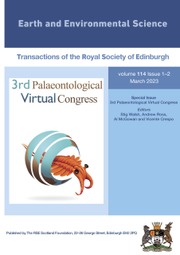Crossref Citations
This article has been cited by the following publications. This list is generated based on data provided by
Crossref.
Moyen, Jean-François
2011.
The composite Archaean grey gneisses: Petrological significance, and evidence for a non-unique tectonic setting for Archaean crustal growth.
Lithos,
Vol. 123,
Issue. 1-4,
p.
21.
van Hunen, Jeroen
and
Moyen, Jean-François
2012.
Archean Subduction: Fact or Fiction?.
Annual Review of Earth and Planetary Sciences,
Vol. 40,
Issue. 1,
p.
195.
Mohan, M. Ram
Singh, S.P.
Santosh, M.
Siddiqui, M.A.
and
Balaram, V.
2012.
TTG suite from the Bundelkhand Craton, Central India: Geochemistry, petrogenesis and implications for Archean crustal evolution.
Journal of Asian Earth Sciences,
Vol. 58,
Issue. ,
p.
38.
Seixas, Luís Antônio Rosa
David, Jean
and
Stevenson, Ross
2012.
Geochemistry, Nd isotopes and U–Pb geochronology of a 2350Ma TTG suite, Minas Gerais, Brazil: Implications for the crustal evolution of the southern São Francisco craton.
Precambrian Research,
Vol. 196-197,
Issue. ,
p.
61.
Ivanic, Timothy J.
Van Kranendonk, Martin J.
Kirkland, Christopher L.
Wyche, Stephen
Wingate, Michael T.D.
and
Belousova, Elena A.
2012.
Zircon Lu–Hf isotopes and granite geochemistry of the Murchison Domain of the Yilgarn Craton: Evidence for reworking of Eoarchean crust during Meso-Neoarchean plume-driven magmatism.
Lithos,
Vol. 148,
Issue. ,
p.
112.
Dantas, Elton Luiz
de Souza, Zorano Sérgio
Wernick, Eberhard
Hackspacher, Peter Christian
Martin, Hervé
Xiaodong, Deng
and
Li, Jian-Wei
2013.
Crustal growth in the 3.4–2.7Ga São José de Campestre Massif, Borborema Province, NE Brazil.
Precambrian Research,
Vol. 227,
Issue. ,
p.
120.
Bagas, Leon
Næraa, Tomas
Kolb, Jochen
Reno, Barry L.
and
Fiorentini, Marco L.
2013.
Partial melting of the Archaean Thrym Complex of southeastern Greenland.
Lithos,
Vol. 160-161,
Issue. ,
p.
164.
Bédard, Jean H.
Harris, Lyal B.
and
Thurston, Phillips C.
2013.
The hunting of the snArc.
Precambrian Research,
Vol. 229,
Issue. ,
p.
20.
Mohan, M. Ram
Piercey, Stephen J.
Kamber, Balz S.
and
Sarma, D. Srinivasa
2013.
Subduction related tectonic evolution of the Neoarchean eastern Dharwar Craton, southern India: New geochemical and isotopic constraints.
Precambrian Research,
Vol. 227,
Issue. ,
p.
204.
Srivastava, Rajesh K.
2013.
Geochemistry of Proterozoic granitoids exposed between Dirang and Tawang, western Arunachal Himalaya, north-eastern India: petrogenetic and tectonic significance.
International Journal of Earth Sciences,
Vol. 102,
Issue. 7,
p.
2043.
Zhang, Chao
Holtz, Francois
Koepke, Jürgen
Wolff, Paul Eric
Ma, Changqian
and
Bédard, Jean H.
2013.
Constraints from experimental melting of amphibolite on the depth of formation of garnet-rich restites, and implications for models of Early Archean crustal growth.
Precambrian Research,
Vol. 231,
Issue. ,
p.
206.
Bédard, Jean H.
and
Harris, Lyal B.
2014.
Neoarchean disaggregation and reassembly of the Superior craton.
Geology,
Vol. 42,
Issue. 11,
p.
951.
Mohan, M. Ram
Sarma, D. Srinivasa
McNaughton, Neal J.
Fletcher, Ian R.
Wilde, Simon A.
Siddiqui, Md. Alam
Rasmussen, Birger
Krapez, Bryan
Gregory, Courtney J.
and
Kamo, Sandra L.
2014.
SHRIMP zircon and titanite U-Pb ages, Lu-Hf isotope signatures and geochemical constraints for ∼2.56Ga granitic magmatism in Western Dharwar Craton, Southern India: Evidence for short-lived Neoarchean episodic crustal growth?.
Precambrian Research,
Vol. 243,
Issue. ,
p.
197.
Jayananda, M.
Gireesh, R. V.
Sekhamo, Kowete-u
and
Miyazaki, T.
2014.
Coeval felsic and Mafic Magmas in neoarchean calc-alkaline magmatic arcs, Dharwar craton, Southern India: Field and petrographic evidence from mafic to Hybrid magmatic enclaves and synplutonic Mafic dykes.
Journal of the Geological Society of India,
Vol. 84,
Issue. 1,
p.
5.
Santosh, M.
Yang, Qiong-Yan
Shaji, E.
Tsunogae, T.
Mohan, M. Ram
and
Satyanarayanan, M.
2015.
An exotic Mesoarchean microcontinent: The Coorg Block, southern India.
Gondwana Research,
Vol. 27,
Issue. 1,
p.
165.
Janoušek, Vojtěch
Moyen, Jean-François
Martin, Hervé
Erban, Vojtěch
and
Farrow, Colin
2016.
Geochemical Modelling of Igneous Processes – Principles And Recipes in R Language.
p.
27.
Moyen, Jean-François
and
Laurent, Oscar
2018.
Archaean tectonic systems: A view from igneous rocks.
Lithos,
Vol. 302-303,
Issue. ,
p.
99.
Nebel, O.
Capitanio, F. A.
Moyen, J.-F.
Weinberg, R. F.
Clos, F.
Nebel-Jacobsen, Y. J.
and
Cawood, P. A.
2018.
When crust comes of age: on the chemical evolution of Archaean, felsic continental crust by crustal drip tectonics.
Philosophical Transactions of the Royal Society A: Mathematical, Physical and Engineering Sciences,
Vol. 376,
Issue. 2132,
p.
20180103.
Zhao, Tianyu
Cawood, Peter A.
Wang, Kai
Zi, Jian-Wei
Feng, Qinglai
Nguyen, Quyen Minh
and
Tran, Dung My
2019.
Neoarchean and Paleoproterozoic K-rich granites in the Phan Si Pan Complex, north Vietnam: Constraints on the early crustal evolution of the Yangtze Block.
Precambrian Research,
Vol. 332,
Issue. ,
p.
105395.
Ahmad, Iftikhar
Mondal, M. E. A.
and
Satyanarayanan, M.
2019.
Geological Evolution of the Precambrian Indian Shield.
p.
179.




